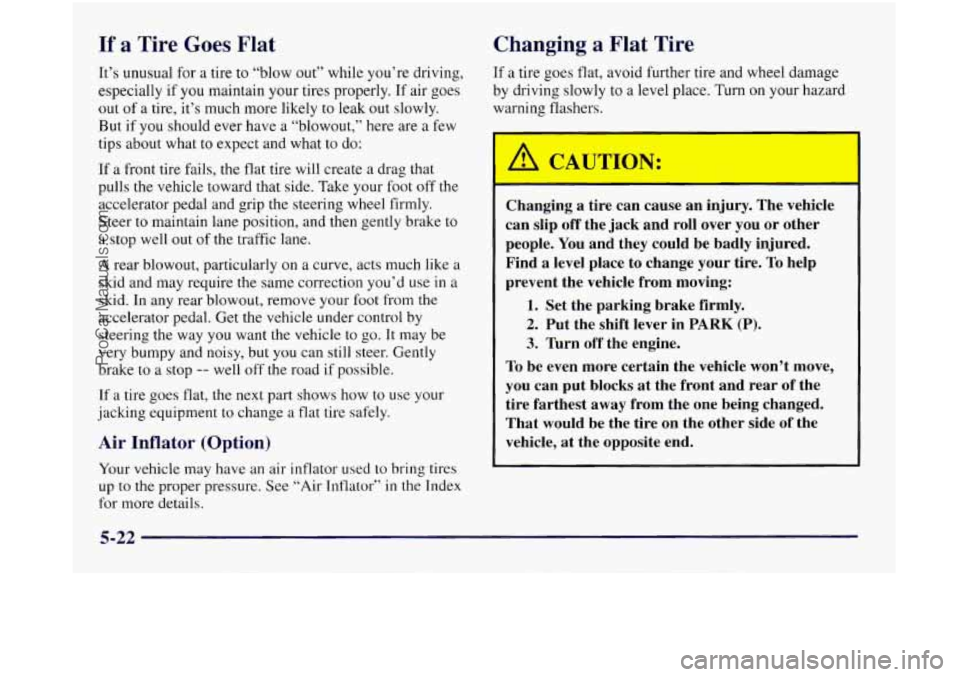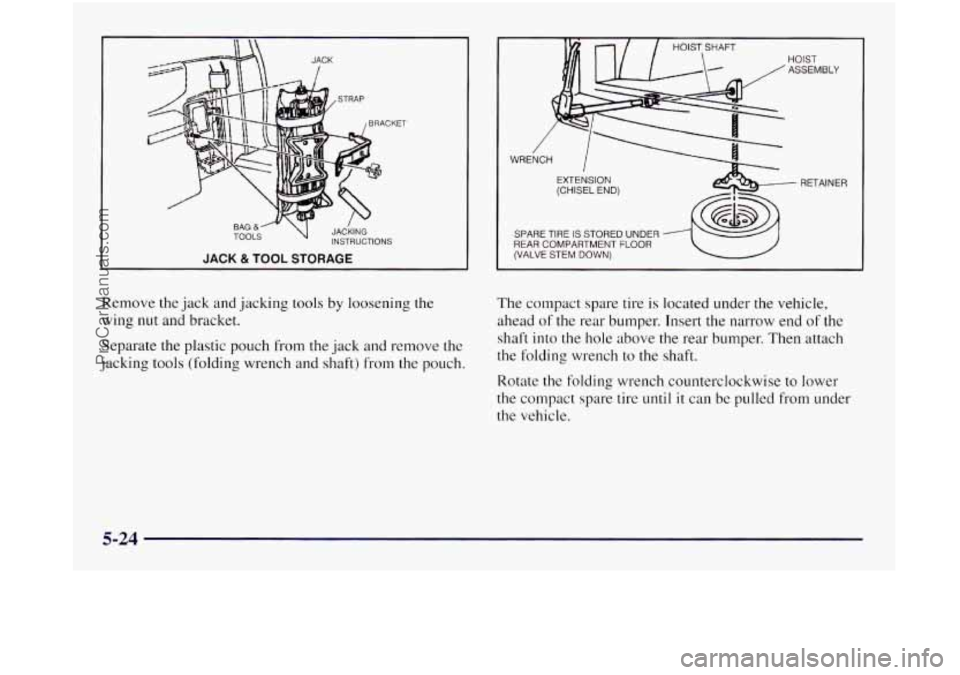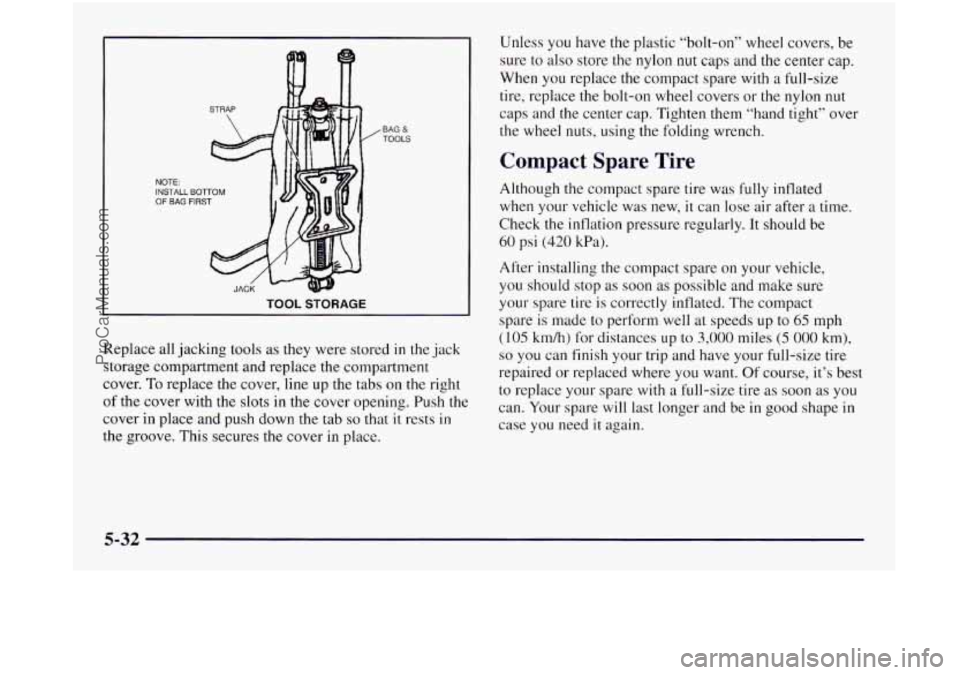jacking OLDSMOBILE SILHOUETTE 1997 Owners Manual
[x] Cancel search | Manufacturer: OLDSMOBILE, Model Year: 1997, Model line: SILHOUETTE, Model: OLDSMOBILE SILHOUETTE 1997Pages: 436, PDF Size: 21.87 MB
Page 286 of 436

If a Tire Goes Flat
It’s unusual for a tire to “blow out” while you’re driving,
especially if you maintain your tires properly. If air goes
out of a tire, it’s much more likely to leak out slowly.
But if you should ever have
a “blowout,” here are a few
tips about what to expect and what to do:
If a front tire fails, the flat tire will create a drag that
pulls the vehicle toward that side. Take your foot off
the
accelerator pedal and grip the steering wheel firmly.
Steer
to maintain lane position, and then gently brake to
a stop well out
of the traffic lane.
A rear blowout, particularly on a curve, acts much like a
skid and may require the same correction you’d use
in a
skid. In any rear blowout, remove your foot from the
accelerator pedal. Get the vehicle under control by
steering the way you want the vehicle to go. It may be
very bumpy and noisy, but you can still steer. Gently
brake
to a stop -- well off the road if possible.
If
a tire goes flat, the next part shows how to use your
jacking equipment to change a flat tire safely.
Air Inflator (Option)
Your vehicle may have an air inflator used to bring tires
up
to the proper pressure. See “Air Inflator” in the Index
for more details.
Changing a Flat Tire
If a tire goes flat, avoid further tire and wheel damage
by driving slowly to a level place. Turn on your hazard
warning flashers.
Changing
a tire can cause an injury. The vehicle
can slip off the jack and roll over you or other
people. You and they could be badly injured.
Find
a level place to change your tire. To help
prevent the vehicle from moving:
1. Set the parking brake firmly.
2. Put the shift lever in PARK (P).
3. lhrn off the engine.
To be even more certain the vehicle won’t move,
you can put blocks at the front and rear of the
tire farthest away from the one being changed.
That would be the tire on the other side
of the
vehicle, at the opposite end.
5-22
ProCarManuals.com
Page 288 of 436

1
STRAP
1 BRACKET
iOOLS VU JACKING INSTRUCTIONS
JACK & TOOL STORAGE
Remove the jack and jacking tools by loosening the
wing nut and bracket.
Separate the plastic pouch from the jack and remove the
jacking
tools (folding wrench and shaft) from the pouch.
HOIST SHAFT
HOIST
ASSEMBLY
EXTENSION
(CHISEL END)
SPARE TIRE
IS STORED UNDER REAR COMPARTMENT FLOOR (VALVE STEM DOWN)
The compact spare tire is located under the vehicle,
ahead
of the rear bumper. Insert the narrow end of the
shaft into the hole above
the rear bumper. Then attach
the folding wrench
to the shaft.
Rotate the folding wrench counterclockwise to lower
the compact spare tire
until it can be pulled from under
the vehicle.
5-24
ProCarManuals.com
Page 296 of 436

NOTE: INSTALL OF BAG - BOTTOM FIRST
TOOL STORAGE
BAG & TOOLS
Replace all jacking tools as they were stored in the jack
storage compartment and replace the compartment
cover.
To replace the cover, line up the tabs on the right
of the cover with
the slots in the cover opening. Push the
cover in place and push down the tab
so that it rests in
the groove. This secures the cover in place. Unless
you have
the plastic “bolt-on” wheel covers, be
sure to also store the nylon
nut caps and the center cap.
When
you replace the compact spare with a full-size
tire, replace the bolt-on wheel covers or
the nylon nut
caps and
the center cap. Tighten them “hand tight” over
the
wheel nuts, using the folding wrench.
Compact Spare Tire
Although the compact spare tire was fully inflated
when your vehicle was new, it can lose air after a time.
Check the inflation pressure regularly. It should be
60 psi (420
kPa).
After installing the compact spare on your vehicle,
you should stop
as soon as possible and make sure
your spare
tire is correctly inflated. The compact
spare is made to perform well at speeds up to
65 mph
(105 km/h) for distances
up to 3,000 miles (5 000 km),
so you can finish your trip and have your full-size tire
repaired or replaced where you want. Of course, it’s best
to replace your spare
with a full-size tire as soon as you
can. Your spare will last longer and be
in good shape in
case you need it again.
5-32
ProCarManuals.com